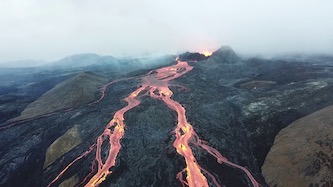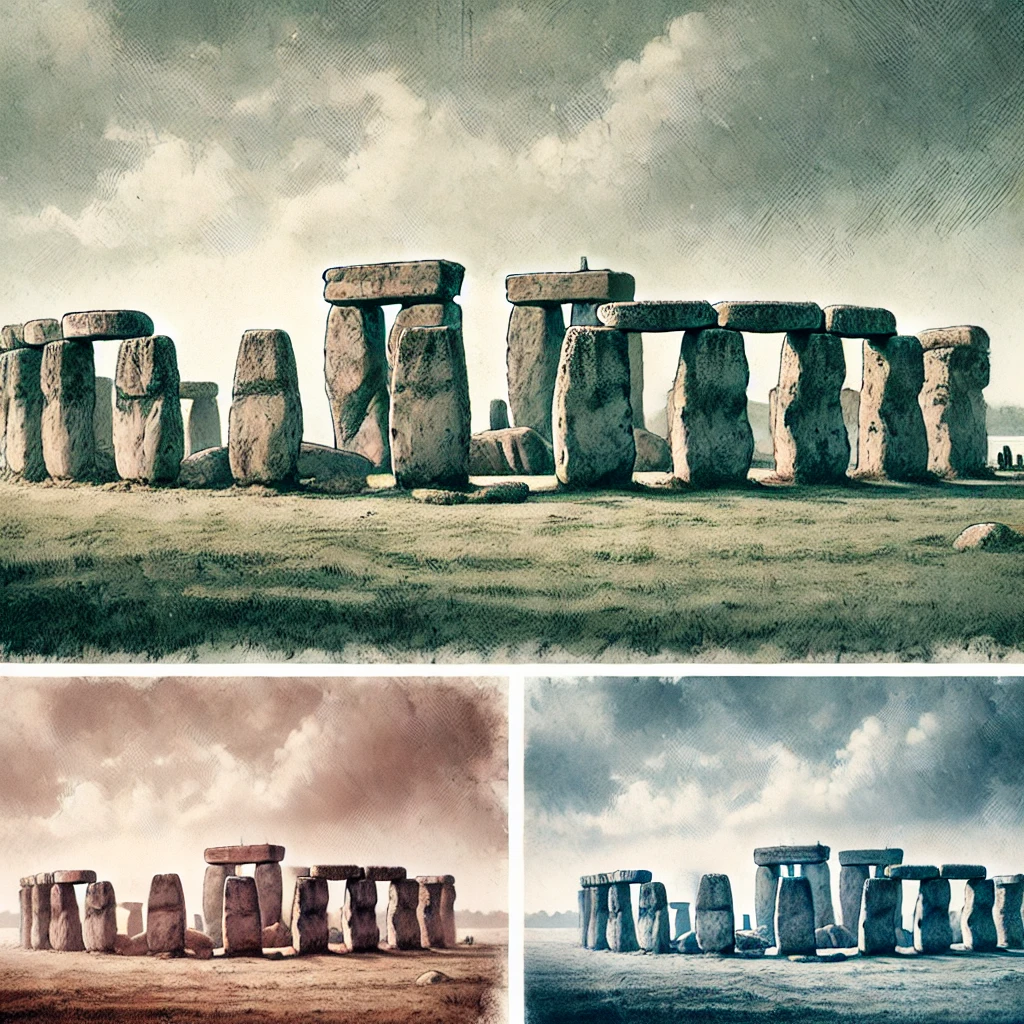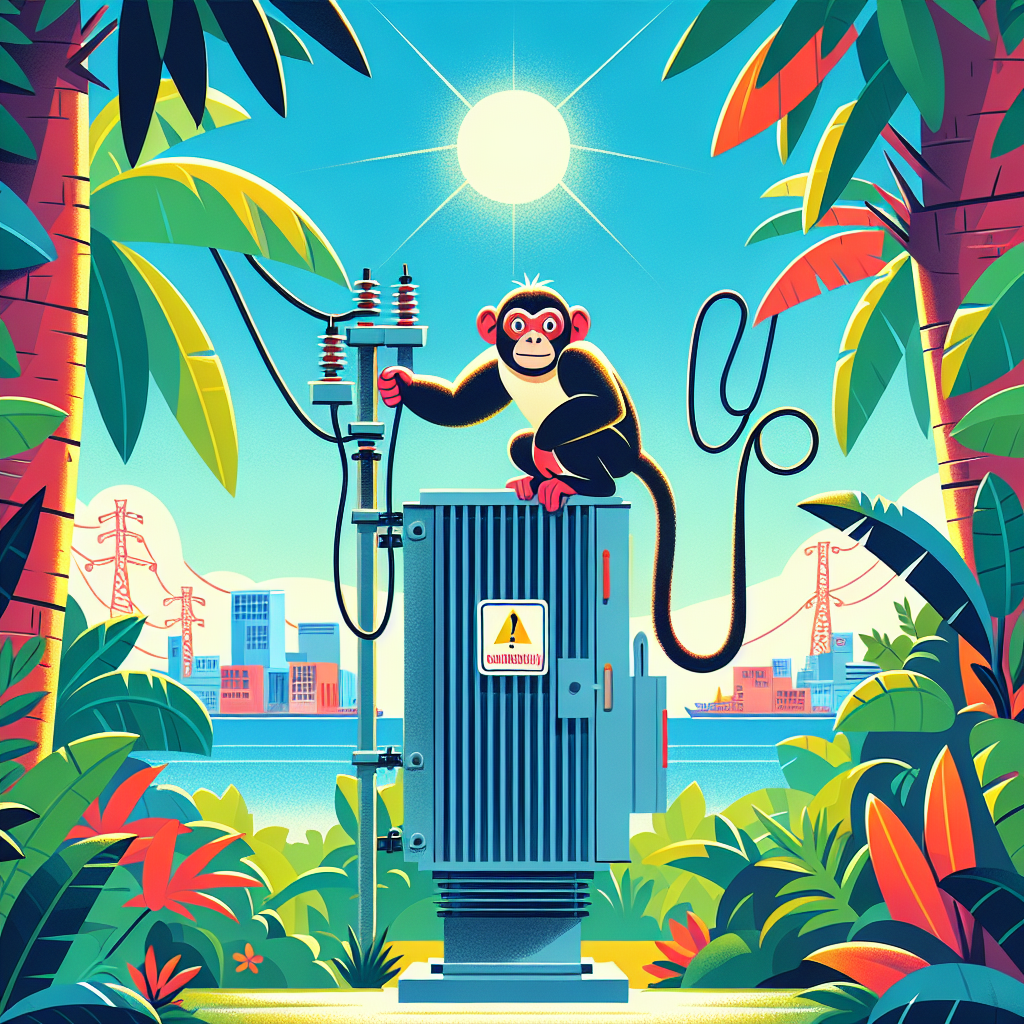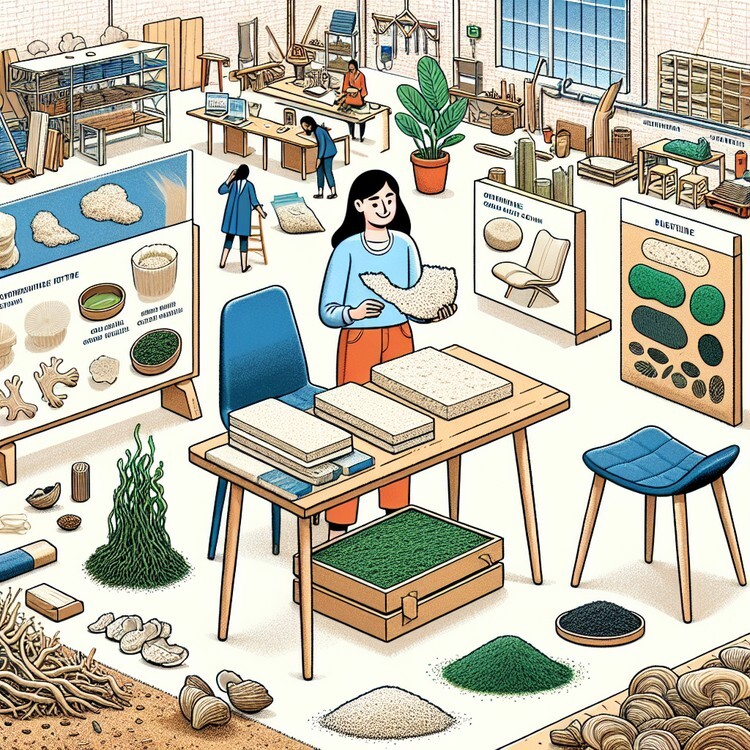The Icelandic Met Office (IMO) has warned that the south-western part of Iceland could have volcanic problems for many years. There have been recent earthquakes and worries that a volcano could erupt soon. Because of this, the small fishing town of Grindavik has been evacuated. This is the first time in 800 years that volcanic eruptions have happened on the Reykjanes Peninsula. The IMO thinks that there will be more eruptions along the peninsula, not just in the same place over and over again. This could go on for a long time.
Dr. Matthew Roberts, who works at the IMO’s office in Reykjavik, showed us a room where they watch for earthquakes. Last Friday, they were surprised to see that magma was going into the ground and causing rocks to break over a distance of 15km. This has never happened before in modern times. They quickly told everyone to leave, and soon there were pictures of cracked roads and damaged houses because of the earthquakes. The town of Grindavik is sinking, which is making the buildings and roads even more damaged. The western part of the town has already sunk more than a meter since last Friday and is still sinking about 4cm every day.
A map with colors shows that the land is collapsing, and one area is very unstable and could have an eruption in the next few days or weeks. If there is an eruption, it could cause a lot of damage to the local area and let out dangerous fumes. Pictures from the air show that the magma is going under a crack that is hundreds of years old. Iceland is used to volcanoes because it is on the Mid-Atlantic Ridge, where two big plates are moving apart. But it has been 50 years since a whole town had to be evacuated.
In 1973, a crack on Heimaey, the biggest of Iceland’s Westman Islands, started shooting out hot lava. Right now, the magma under the Reykjanes Peninsula is about 800m below the surface. It might take weeks or even longer before people can go back there. Dr. Roberts thinks that there won’t be a big explosion, but that might not be a good thing. There could be a smaller eruption with lava coming out of many cracks for a long time. They are making plans to protect the geothermal plant and close the famous Blue Lagoon spa. Iceland has ways to deal with lava, but Dr. Roberts knows that nature always wins in the end.
Original news source: Iceland volcano: Peninsula faces ‘decades’ of instability (BBC)
Listen
Slow
Normal
Fast
Group or Classroom Activities
Warm-up Activities:
– News Summary
Instructions: Students are divided into small groups. Each group is tasked with summarizing the article in their own words, focusing on the main points. They will then present their summaries to the class. Aim for a concise summary in under two minutes per group.
– Opinion Poll
Instructions: Create a list of statements about the situation in the article, such as “Volcanic eruptions can have long-term benefits for the environment” or “It is better to permanently relocate residents from areas with frequent volcanic activity.” Students will walk to different areas of the classroom to show their agreement or disagreement with each statement. Afterward, discuss the reasons behind their opinions as a class.
– Sketch It
Instructions: In pairs, students will choose a scene or aspect from the article to illustrate, without writing any words. The rest of the class must guess what the drawing represents. This activity helps with comprehension and encourages students to think creatively about the content of the article.
– Headline Creation
Instructions: Individually or in pairs, students create a compelling newspaper headline for the article that captures the essence of the story. Encourage them to be creative and think about what would grab a reader’s attention. Share and discuss the headlines as a class.
– Future Predictions
Instructions: Based on the information in the article, students will write their predictions about what will happen in Grindavik and the Reykjanes Peninsula in the next year. They can write from the perspective of a resident, a scientist, or a government official. Share the predictions with the class and discuss the possible outcomes.
Comprehension Questions:
1. What has the Icelandic Met Office warned about the south-western part of Iceland?
2. How long has it been since volcanic eruptions last occurred on the Reykjanes Peninsula?
3. What unusual event did the IMO’s office in Reykjavik observe last Friday?
4. What has been the impact of the sinking land on the town of Grindavik?
5. What does the color-coded map indicate about the land in the area?
6. When was the last time a whole town in Iceland had to be evacuated due to volcanic activity, and what happened?
7. How deep is the magma under the Reykjanes Peninsula, and what are the possible consequences of its movement?
8. What measures are being taken to protect local facilities, and what does Dr. Roberts say about the power of nature?
Go to answers ⇩
Listen and Fill in the Gaps:
The Icelandic Met Office (IMO) has warned that the south-western part of Iceland could have volcanic problems for many years. There have been recent earthquakes and worries that a volcano could (1)______ soon. Because of this, the small fishing town of (2)______ has been evacuated. This is the first time in 800 years that volcanic eruptions have happened on the Reykjanes Peninsula. The IMO thinks that there will be more eruptions along the (3)______, not just in the same place over and over again. This could go on for a long time.
Dr. Matthew Roberts, who (4)______ at the IMO’s office in Reykjavik, showed us a room where they watch for (5)______. Last Friday, they were surprised to see that magma was going into the ground and causing rocks to break over a distance of 15km. This has never happened before in modern times. They quickly told everyone to leave, and soon there were (6)______ of (7)______ roads and (8)______ houses because of the earthquakes. The town of Grindavik is sinking, which is making the buildings and roads even more damaged. The western part of the town has already sunk more than a meter since last Friday and is still sinking about 4cm every day.
A map with colors shows that the land is collapsing, and one area is very unstable and could have an eruption in the next few days or weeks. If there is an eruption, it could cause a lot of damage to the (9)______ area and let out dangerous fumes. Pictures from the air show that the magma is going under a (10)______ that is hundreds of (11)______ old. Iceland is used to volcanoes because it is on the Mid-Atlantic Ridge, where two big plates are moving apart. But it has been 50 years since a whole town had to be evacuated.
In 1973, a crack on Heimaey, the (12)______ of Iceland’s Westman Islands, (13)______ shooting out hot lava. Right now, the magma under the Reykjanes Peninsula is about 800m below the surface. It might take weeks or even longer before people can go back there. Dr. Roberts thinks that there won’t be a big explosion, but that might not be a good thing. There could be a smaller eruption with lava coming out of many cracks for a long time. They are (14)______ plans to protect the geothermal plant and close the (15)______ Blue Lagoon spa. Iceland has ways to deal with lava, but Dr. Roberts (16)______ that nature always wins in the end.
Go to answers ⇩
Discussion Questions:
Students can ask a partner these questions, or discuss them as a group.
1. What is a volcano and have you ever seen one in real life?
2. How would you feel if you had to leave your home because of a natural disaster?
3. Do you think living near a volcano is scary? Why or why not?
4. What do you think are the good and bad points about living in a town like Grindavik?
5. Have you ever experienced an earthquake? What was it like?
6. Why do you think people choose to live in places that are known for natural disasters?
7. What would you take with you if you had to evacuate your home quickly?
8. Do you think it’s important for towns to have emergency plans for disasters? Why?
9. How do you think the people of Grindavik are feeling right now?
10. What do you know about the ways people can protect themselves from volcanic eruptions?
11. Do you think scientists can predict volcanic eruptions accurately? Why or why not?
12. What is the most interesting fact you’ve learned about volcanoes?
13. If you were in charge of a town near a volcano, what would you do to keep people safe?
14. Do you like visiting places like the Blue Lagoon spa, even if there’s some risk involved?
15. Do you think nature is more powerful than human technology? Why or why not?
Individual Activities
Vocabulary Meanings:
Match each word to its meaning.
Words:
1. volcanic
2. earthquakes
3. evacuation
4. magma
5. damage
6. eruption
7. unstable
8. fumes
Meanings:
(a) Gases or smoke released during a volcanic eruption
(b) Shaking of the ground caused by the movement of tectonic plates
(c) The act of leaving a place for safety reasons
(d) Harm or destruction caused by something
(e) The sudden release of volcanic material, such as lava and ash
(f) Related to a volcano or volcanic activity
(g) Hot, molten rock found beneath the Earth’s surface
(h) Not steady or secure, likely to change or collapse
Go to answers ⇩
Multiple Choice Questions:
1. Why has the small fishing town of Grindavik been evacuated?
(a) The town is sinking and causing damage to buildings and roads.
(b) There have been recent earthquakes and worries of a volcanic eruption.
(c) The land is collapsing and an eruption is expected in the next few days or weeks.
(d) The magma is going under a crack that is hundreds of years old.
2. What is the Reykjanes Peninsula known for?
(a) It is sinking and causing damage to buildings and roads.
(b) It is experiencing volcanic eruptions for the first time in 800 years.
(c) It is an area prone to earthquakes and volcanic activity.
(d) It is the location of the famous Blue Lagoon spa.
3. What caused the recent earthquakes in Iceland?
(a) The sinking of the town of Grindavik.
(b) The collapse of the land on the Reykjanes Peninsula.
(c) The movement of two big plates on the Mid-Atlantic Ridge.
(d) Magma going into the ground and causing rocks to break.
4. How long has it been since a whole town in Iceland had to be evacuated?
(a) 800 years
(b) 1973
(c) 50 years
(d) A few weeks
5. What could happen if there is an eruption in the area?
(a) The town of Grindavik could sink even further.
(b) The magma could go under a crack that is hundreds of years old.
(c) The geothermal plant and Blue Lagoon spa could be protected.
(d) It could cause a lot of damage to the local area and release dangerous fumes.
6. How deep is the magma under the Reykjanes Peninsula?
(a) About 800m below the surface.
(b) About 15km below the surface.
(c) About a meter below the surface.
(d) About 4cm below the surface.
7. What does Dr. Roberts think will happen in terms of the eruption?
(a) The town of Grindavik will sink even further.
(b) The magma will go under a crack that is hundreds of years old.
(c) There won’t be a big explosion, but there might be a smaller eruption with lava coming out of many cracks for a long time.
(d) The geothermal plant and Blue Lagoon spa will be protected.
8. How does Dr. Roberts feel about nature?
(a) Nature always wins in the end.
(b) Nature can be controlled and prevented from causing damage.
(c) Nature is unpredictable and can be dangerous.
(d) Nature is not a concern in this situation.
Go to answers ⇩
True or False Questions:
1. The Icelandic Met Office predicts that there will be more eruptions along the peninsula, not just in the same location repeatedly.
2. Magma entering the ground and causing rocks to break over a distance of 15km is a new and surprising occurrence in modern times.
3. The magma under the Reykjanes Peninsula is not currently about 800m below the surface, and people can return to the area in a matter of days.
4. Recent earthquakes have not raised concerns about the possibility of a volcanic eruption in the near future.
5. The small fishing town of Grindavik has not been evacuated as a precautionary measure.
6. The Icelandic Met Office has issued a warning about potential volcanic problems in the south-western part of Iceland.
7. This is the first time in 800 years that volcanic eruptions have occurred on the Reykjanes Peninsula.
8. The sinking of the town of Grindavik is not causing further damage to buildings and roads.
Go to answers ⇩
Write a Summary:
Write a summary of this news article in two sentences.
Check your writing now with the best free AI for English writing!
Writing Questions:
Answer the following questions. Write as much as you can for each answer.
Check your answers with our free English writing assistant!
1. What has prompted the Icelandic Met Office to issue a warning about the south-western part of Iceland?
2. How long has it been since volcanic eruptions last occurred on the Reykjanes Peninsula?
3. What unusual geological activity did the IMO observe last Friday, and what was the immediate consequence for the town of Grindavik?
4. What does the map with colors indicate about the land, and what are the potential dangers of an eruption?
5. What historical volcanic event does the article mention, and how does it relate to the current situation on the Reykjanes Peninsula?
Answers
Comprehension Question Answers:
1. What has the Icelandic Met Office warned about the south-western part of Iceland?
The Icelandic Met Office has warned that the south-western part of Iceland could experience volcanic problems for many years, with potential eruptions.
2. How long has it been since volcanic eruptions last occurred on the Reykjanes Peninsula?
It has been 800 years since volcanic eruptions last occurred on the Reykjanes Peninsula.
3. What unusual event did the IMO’s office in Reykjavik observe last Friday?
Last Friday, the IMO’s office in Reykjavik observed magma intruding into the ground, causing rocks to break over a 15km distance, an event that hasn’t occurred in modern times.
4. What has been the impact of the sinking land on the town of Grindavik?
The sinking land has caused significant damage to buildings and roads in Grindavik, with the western part of the town sinking more than a meter and continuing to sink about 4cm every day.
5. What does the color-coded map indicate about the land in the area?
The color-coded map indicates that the land is collapsing and that one area is particularly unstable, suggesting that an eruption could occur there soon.
6. When was the last time a whole town in Iceland had to be evacuated due to volcanic activity, and what happened?
The last time a whole town in Iceland had to be evacuated due to volcanic activity was in 1973 when a fissure on Heimaey Island began erupting.
7. How deep is the magma under the Reykjanes Peninsula, and what are the possible consequences of its movement?
The magma under the Reykjanes Peninsula is about 800 meters below the surface, and its movement could lead to eruptions that might not be explosive but could produce lava flows for a prolonged period.
8. What measures are being taken to protect local facilities, and what does Dr. Roberts say about the power of nature?
Measures are being taken to protect the geothermal plant and to close the Blue Lagoon spa. Dr. Roberts acknowledges that no matter the precautions taken, nature ultimately has the upper hand.
Go back to questions ⇧
Listen and Fill in the Gaps Answers:
(1) erupt
(2) Grindavik
(3) peninsula
(4) works
(5) earthquakes
(6) pictures
(7) cracked
(8) damaged
(9) local
(10) crack
(11) years
(12) biggest
(13) started
(14) making
(15) famous
(16) knows
Go back to questions ⇧
Vocabulary Meanings Answers:
1. volcanic
Answer: (f) Related to a volcano or volcanic activity
2. earthquakes
Answer: (b) Shaking of the ground caused by the movement of tectonic plates
3. evacuation
Answer: (c) The act of leaving a place for safety reasons
4. magma
Answer: (g) Hot, molten rock found beneath the Earth’s surface
5. damage
Answer: (d) Harm or destruction caused by something
6. eruption
Answer: (e) The sudden release of volcanic material, such as lava and ash
7. unstable
Answer: (h) Not steady or secure, likely to change or collapse
8. fumes
Answer: (a) Gases or smoke released during a volcanic eruption
Go back to questions ⇧
Multiple Choice Answers:
1. Why has the small fishing town of Grindavik been evacuated?
Answer: (b) There have been recent earthquakes and worries of a volcanic eruption.
2. What is the Reykjanes Peninsula known for?
Answer: (b) It is experiencing volcanic eruptions for the first time in 800 years.
3. What caused the recent earthquakes in Iceland?
Answer: (d) Magma going into the ground and causing rocks to break.
4. How long has it been since a whole town in Iceland had to be evacuated?
Answer: (c) 50 years
5. What could happen if there is an eruption in the area?
Answer: (d) It could cause a lot of damage to the local area and release dangerous fumes.
6. How deep is the magma under the Reykjanes Peninsula?
Answer: (a) About 800m below the surface.
7. What does Dr. Roberts think will happen in terms of the eruption?
Answer: (c) There won’t be a big explosion, but there might be a smaller eruption with lava coming out of many cracks for a long time.
8. How does Dr. Roberts feel about nature?
Answer: (a) Nature always wins in the end.
Go back to questions ⇧
True or False Answers:
1. The Icelandic Met Office predicts that there will be more eruptions along the peninsula, not just in the same location repeatedly. (Answer: True)
2. Magma entering the ground and causing rocks to break over a distance of 15km is a new and surprising occurrence in modern times. (Answer: True)
3. The magma under the Reykjanes Peninsula is not currently about 800m below the surface, and people can return to the area in a matter of days. (Answer: False)
4. Recent earthquakes have not raised concerns about the possibility of a volcanic eruption in the near future. (Answer: False)
5. The small fishing town of Grindavik has not been evacuated as a precautionary measure. (Answer: False)
6. The Icelandic Met Office has issued a warning about potential volcanic problems in the south-western part of Iceland. (Answer: True)
7. This is the first time in 800 years that volcanic eruptions have occurred on the Reykjanes Peninsula. (Answer: True)
8. The sinking of the town of Grindavik is not causing further damage to buildings and roads. (Answer: False)
Go back to questions ⇧














